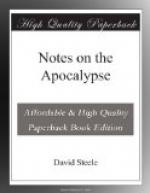I do not believe that infidel France, whether republican or monarchical, nor the Papacy, nor the Church of Rome, is the Antichrist of the apostle John; yet I do believe that all these are essential elements in his composition. The following are the principal component parts of that complex moral person, as defined by the Holy Spirit, by which any disciple of Christ without much learning may identify John’s Antichrist. His elemental parts are three, and only three, and all presented in the thirteenth chapter of Revelation. The “beast of the sea,” (vs. 1, 2,) the “beast of the earth,” (v. 11,) and the “image of, or to the first beast,” (v. 14,) that is, the Roman empire, the Roman church and the Pope: all these in combination, professing Christianity; these, with their adjuncts as subordinate agencies constitute the Apocalyptic Antichrist. Besides this personage, well defined by the inspired prophets, Daniel, Paul, John and others, there is no other Antichrist. An “infidel king, a professed atheist,” as distinct from this one and symbolized in prophetic revelation, I find not. I conclude that such a personage is wholly chimerical, framed as a creature of a lively imagination.
THE IMAGE OF THE BEAST.
Mr. Faber is unsuccessful in his interpretation of the “image of the beast.” His reasoning is ingenious, specious and intelligible as usual. He labours to prove that the worshipping of images by the Papists is the meaning of the symbol. Material images, however, whether of papal origin or otherwise, are harmless vanities: “for they cannot do evil, neither also is it in them to do good,” (Jer. x. 5.) The case is quite otherwise with this image. It has “life, speaks, and has power to kill,” (Rev. xiii. 15.) These properties of John’s “image” are so opposite to those of the Papal images, that they effectually confute Mr. Faber’s fanciful, not to say whimsical theory. It has been already shown that the “image” symbolizes the Papacy, the fac-simile of the Roman emperor.
THE BEAST’S “deadly wound.”
The Erastian heresy, the usual concomitant of prelacy, will readily account for Mr. Faber’s explanation of the “deadly wound,” which the first beast received in his sixth head. Constantine, he thinks, inflicted that wound by abolishing paganism. He writes as though the beast had been actually killed, and had lain literally dead for a period of nearly three centuries! (viz., from 313 till 606.) Yet the apostle assures us that the “deadly wound was healed.” The beast did not die. Daniel gives no hint of the death of his fourth beast, which is the same as John’s beast of the sea, until his final destruction at the close of the 1260 years. It was in fact under the reigns of Constantine and his successors, that ambitious pastors were nurtured into antichristian prelates, and passed by a natural transition into




